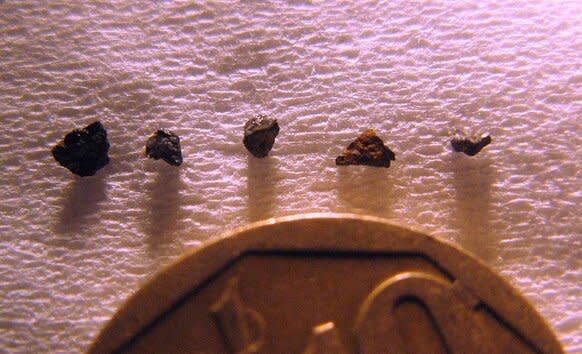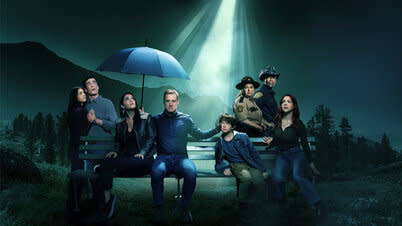Meteorite bears the imprint of a supernova from before the solar system was born
A very strange meteorite found in western Egypt in 1996 may have tiny pieces of the debris from a supernova in it, and not just any supernova but one created by the explosion of a white dwarf, the remnant core of a once Sun-like star. If so, this would be the first evidence of a relatively nearby supernova of that kind that occurred before the Sun and planets were born [link to paper].
The stone is called Hypatia, and right away it was seen to be an oddball. The idea that it even was a meteorite at all was at first contested, but laboratory studies showed that the structure and elemental composition was similar enough to one kind of meteorite that it appears to be extraterrestrial in origin.
That type of meteorite is called carbonaceous chondrite. These generally have a high carbon content, and many contain chondrules, which are tiny, generally roundish grains of material that formed early on in the process that formed the Sun, planets, asteroids, and everything else in our solar system.
One specific kind, called the CI group, is very low in chondrules or doesn’t have any at all, and Hypatia appears to be this kind. This group of meteorites is very old, meaning they formed very early, before the Sun and planets coalesced out of a cloud of gas and dust, the solar nebula. In fact, the abundance of an isotope of xenon in Hypatia indicates it formed less than 40 million years after the solar nebula started to collapse.

A fragment of the unusual meteorite named Hypatia, measuring just a few centimeters across. Elements in this meteorite indicate they may have come from a white dwarf supernova. Photo: Roman Serra
Examining Hypatia is difficult because only a very small fragment weighing 30 grams — a little over an ounce — was found. Still, studies showed it has two different kinds of bulk material in it. One seems to have no elements in it heavier than oxygen, while the other has measurable amounts of heavier elements like iron and nickel.
Those elements are interesting indeed: They are formed when stars explode, going supernova. The blast is so powerful that thermonuclear fusion occurs in the ejected material, creating heavy elements.
However, it’s the relative abundances of these elements that are important. How much silicon there is compared to iron, for example, can tell you more specifically about the origin of the material. In the new study, scientists found that these grains in Hypatia were extremely deficient in silicon and manganese compared to iron, and that’s very strange.
Looking at elemental creation processes in different kinds of supernovae, the scientists were able to rule out the kind that comes from the core collapse of a massive star at the end of its life; that doesn’t make the elements in the right proportions to match Hypatia.

The expanding debris from Kepler's Supernova in 1604, a Type Ia explosion of a white dwarf in the Milky Way galaxy. Credit: X-ray: NASA/CXC/SAO/D.Patnaude, Optical: DSS
Another kind of supernova, called a Type Ia, occurs when an extremely dense white dwarf — the compressed core of a star like the Sun left over after the star turns into a red giant and blows away its outer layers, exposing the core to space — accumulates material from a binary companion star. It can get so much material piling up that the extreme gravity of the white dwarf ignites fusion, creating so much energy the star tears itself apart and explodes. There are different subclasses of this kind of supernova, including one where the white dwarf accumulates a shell of helium from the other star, which, when it fuses, triggers the much more energetic fusion of carbon inside the dwarf.
This is not a hugely common kind of supernova — though the very first extragalactic supernova ever seen, SN 1885A in the Andromeda galaxy, was of this kind* — but they do create a unique elemental abundance, and models show that this matches that of Hypatia well enough to be very suspicious.

Small fragments of the Hypatia meteorite with a coin for size comparison. Photo: University of Johannesburg
The high carbon content of Hypatia may have a similar origin. Before becoming a white dwarf the star is first a red giant, and these can have a lot of carbon in them that it blows away into space, forming sooty grains of material generically called dust. The supernova may have occurred inside a cloud of this dust, and these aggregated together. Eventually this material found its way to the nebula from which the solar system formed. That’s not too unusual; we do know that some carbon in meteorites came from other stars that polluted the solar nebula, too.
All this is not yet — pardon the expression — set in stone, though. Hypatia is small and not easy to examine in standard ways, and some of the conclusions drawn go against standard ideas. For example, the current thinking is that most material in the solar nebula was well mixed, but the stuff inside Hypatia is not terribly well mixed. That’s not a deal breaker, but it does indicate that this new study does — again, pardon me — go against the grain.
If this idea does hold up it will be the first direct evidence of a nearby white dwarf supernova that occurred sometime before our planet even formed. It possibly wasn’t the only supernova, or the only source of interstellar material that seeded our birth nebula, but being able to pin this down would be very revealing about what happened in space to form our solar system.
Mind you, everything you see around you — including all the atoms inside you — were made from the material in this pre-solar nebula. As Carl Sagan said, you are literally star stuff.
And you are exploded star stuff. Supernova stuff. It’s an amazing thought, made even more amazing by being demonstrably true.
* I happen to know this because the very first paper I ever co-authored was on 1885A, and while my advisor Roger Chevalier did the lion’s share of the work on that paper, I read a lot about these events and learned quite a bit about them at the time.


